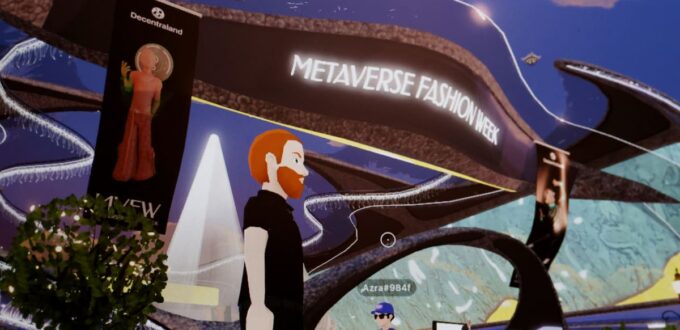Parsons, FIT, Drexel, SCAD and Pratt are just a few schools committed to metaeducation.
The last few years have brought about a shift in how people use technology in all facets of their lives. More than ever, virtual realities, decentralized transactions and non-fungible tokens are altering how we approach everything from social life to business to creativity.
In the past year alone, Prada‘s linked its monthly physical Timecapsule to NFTs that grant access to global Prada Crypted and special events. Meanwhile, Gucci partnered with animated celebrities company Superplastic to release 10 unique NFTs. The metaverse has become so popular, there’s even a Metaverse Fashion Week with brands like Etro, Dundas and Dolce & Gabbana.
Fashion schools have been quick to adapt to these developments, bolstering their digital curriculums in order to keep up with industry demands.
At the Parsons School of Design, metaverse learning experiences are part of the core curriculum during students’ junior year. There’s a specialized studio class in which “students learn intensive 3D modeling software,” says Soojin Kang, an assistant professor of fashion technology, for example. Students learn the traditional skills of garment-making — like creating patterns or sewing — digitally. By senior year, those focusing on digital fashion take Senior Thesis 1 and Thesis 2 classes, both of which yield digital-heavy outcomes and cover skills such as 3D modeling, rendering and other hybrid technical aspects.
To further cement its digital education, the school also partnered with online game platform Roblox to develop a course through which students create hyper-realistic and inclusive 3D digital apparel.
Drexel University offers a range of innovative classes like “Fashion Design in the 3D Space” and “CAD Patternmaking”. But the peak of its metaverse curriculum might just be a historic costume virtual fashion course, titled “Costuming the Metaverse”: Kathi Martin, the associate director of graduate fashion design at Drexel, says the class was initially developed for gaming and animation students, but the construction of virtual spaces has also allowed fashion students to drape and pattern-make on avatars. It culminates in an immersive Medieval-inspired project, in which students create detailed period costumes by designing appropriate textiles, silhouettes and embellishments — all in the metaverse.
Fashion School of Technology (FIT) recently introduced several new metaverse courses to its curriculum. “First Year Experience” educates students as early as freshman year about the metaverse, Web3, cryptocurrency and non-fungible tokens. Other additions include “Understanding, Developing Web 3.0 Business Opportunities and NFTs” and “Introduction to Blockchain for Creative Businesses.”
The metaverse is novel and ever-changing, which means schools must adapt accordingly. At FIT, the faculty remains open-minded, and frequently evolves its curriculum in response to these trends, which “offers an unparalleled win-win for the students and the creative/fashion sector in which we serve” according to Vincent Quan, professor and department chair of fashion business management at FIT SUNY Korea.
For the Savannah College of Art and Design (SCAD), the push toward meta-education is opening students’ doors to new opportunities and alternative career paths in fashion.
“Obviously, we’re focused on the current and future employment opportunities in this field… We think it’s essential that our next generation of SCAD graduates play a defining role in shaping the direction of Web3,” says Dirk Standen, dean of SCAD’s school of fashion. “Fashion and tech companies can benefit from their input.”
For instance, SCAD’s sneaker design minor program implements accessory design strategies geared toward the metaverse. “We’re using the Oculus Quest 2 VR headsets to teach our students to 3D model athletic footwear and other accessories,” says Michael Mack, professor of accessory design and sneaker design at SCAD. “Accessory and sneaker design is diving more heavily than ever before into the virtual and 3D space, and we’re preparing our students to be at the forefront of design and lead the way as they embark on their creative professions.”
Pratt Institute, metaverse courses are part of a larger push toward building a responsible future. These electives — which cover new media, artificial intelligence, AR/VR, interactive installation and physical comp coding for artists — engage students in critical thought surrounding how decentralized technologies will impact the future of design and the ethics around that.
“We felt it was important to introduce curriculum exploring ethical questions and considerations about how this technology is restructuring the relationship between fashion creation and consumption” says Tessa Maffucci, adjunct assistant professor and assistant chairperson in Pratt Institute’s Fashion Design department. “In the fashion context, especially, decentralized models raise important questions about authenticity, creativity and ownership – and present new opportunities to design in collaboration with others, to design with empathy and to explore equity-centered and community-based design.”
These new curriculums are part of our new reality — and educators shaping the minds of the next generation of creatives are adapting accordingly.
Never miss the latest fashion industry news. Sign up for the Fashionista daily newsletter.
Similar posts
Disgraced crypto bro set to turn on Tom Brady, Larry David in FTX lawsuit – The Independent
April 22, 2024Disgraced crypto bro set to turn on Tom Brady, Larry David in FTX lawsuit The Independent
Jailed FTX founder Sam Bankman-Fried turns on his celebrity endorsers including Tom Brady, Gisele Bundchen and – Daily Mail
April 22, 2024Jailed FTX founder Sam Bankman-Fried turns on his celebrity endorsers including Tom Brady, Gisele Bundchen and Daily Mail
Bankman-Fried Agrees to Help Sue Celebrity Crypto Promoters – PYMNTS.com
April 21, 2024Bankman-Fried Agrees to Help Sue Celebrity Crypto Promoters PYMNTS.com

No Comments Yet